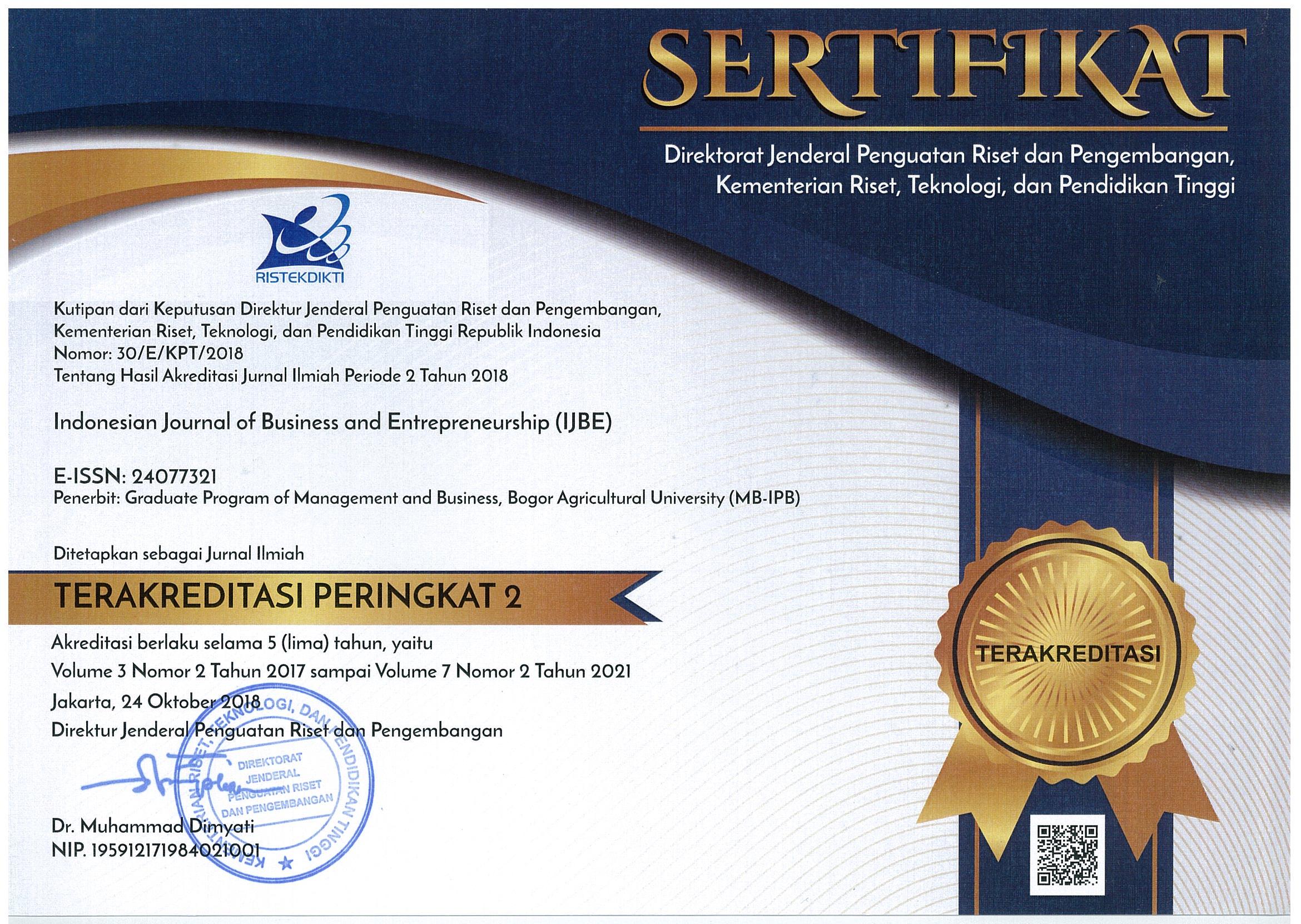TESTING ON PECKING ORDER THEORY AND ANALYSIS OF COMPANY’S CHARACTERISTIC EFFECTS ON EMITTEN’S CAPITAL STRUCTURE
Abstract
Pecking Order Theory (POT) states that hierarchy fundings based on the cheapest cost coming from internal fund, followed by external fund are needed to determine the capital structure. The research objectives were to examine the concept of POT in agriculture companies listed on Indonesia Stock Exchange in order to decide the capital structure policies as well as to analyse the effects of company’s characteristics to the emitten capital structure. The research used regression analysis with pooled least square (PLS) method in order to test POT, while the fixed effect model (FEM) was applied to analyze the effect of company’s characteristics on capital structure. Regression analysis in evaluating pecking order theory’s concept shows that internal funding deficit significantly gives positive influence to the change of long term debts. Regression analysis resulted from company’s characteristics (profitability, size, growth, tangibility and liquidity) shows that the company’s size and growth have significant positive effects on capital structure (leverage), whereas company’s profitability and liquidity have significant negative effects on capital structure (leverage). By contrast, company’s assets structure (tangibility) do not give significantly influence on capital structure (leverage) in 10% level of significance. The research shows that issuers in agricultural sector have implemented the concept of POT through the hierarchy usage of the cheapest financing from the internal as a priority followed by the external financing (debt).Keywords: Pecking Order Theory, capital structure, company’s characteristics, PLS, FEM
ABSTRAK
Pecking Order Theory menyatakan bahwa penentuan struktur modal yang optimal didasarkan pada keputusan pendanaan secara hirarki berdasarkan biaya modal yang paling murah yang bersumber pada dana internal, baru kemudian menggunakan sumber dana eksternal. Penelitian ini bertujuan menguji penggunaan konsep Pecking Order Theory pada emiten di sektor pertanian yang terdaftar di BEI dalam menentukan kebijakan struktur modal serta menganalisis pengaruh karakteristik emiten di sektor pertanian terhadap struktur modal. Penelitian ini menggunakan analisis regresi dengan metode pooled least square (PLS) untuk pengujian konsep Pecking Order Theory, sedangkan dalam menganalisis pengaruh karakteristik emiten di sektor pertanian terhadap struktur modal digunakan metode fixed effect model (FEM). Hasil pembuktian konsep pecking order theory menunjukkan bahwa defisit pendanaan internal berpengaruh positif secara signifikan terhadap perubahan utang jangka panjang. Sedangkan hasil analisis regresi antara karakteristik perusahaan (profitability, size, growth, tangibility dan liquidity) menunjukkan bahwa size dan growth memiliki pengaruh positif signifikan terhadap struktur modal, profitability dan liquidity memiliki pengaruh negatif signifikan terhadap struktur modal, dan tangibility tidak memiliki pengaruh yang signifikan terhadap leverage pada tingkat signifikansi 10%.Hasil analisis menunjukkan emiten di sektor pertanian telah mengikuti kaidah pecking order theory melalui jenjang pemanfaatan sumber pembiayaan dari urutan termurah yaitu pendanaan internal dan kemudian pembiayaan eksternal yang paling murah (utang).
Kata kunci: Pecking Order Theory, struktur modal, karakteristik perusahaan, PLS, FEM
Downloads
References
Andati T, Siregar H, Sinaga BM, Achsani NA. 2012. Liberalisasi keuangan dan pengaruhnya terhadap nilai Q-Tobin sektor industri dasar dan kimia dan perbankan. Jurnal Managemen & Agribisnis 9(1): 13–22.
Atiyet BA. 2012. The pecking order theory and the static trade off theory: comparison of the alternative explanatory power in French Firms. Journal of Business Studies Quarterly 4(1): 1–14.
Bank Indonesia.2014. Statistik ekonomi dan keuangan Indonesia tahun 2014. http://www.bi.go.id/id/statistik/seki/terkini/moneter/Contents/Default.aspx [3 April 2015].
Frank M, Goyal V. 2003. Testing the pecking order theory of capital structure. Journal of Financial Economics 97: 217–248.
Gujarati DN. 1993. Ekonomi Dasar. Jakarta: Erlangga.
Hossain F, Ali A. 2012. Impact of firm specific factors on capital structure decision: an empirical study of Bangladeshi Companies. International Journal of Business Research and Management 3(4): 163–182.
Hsu CH, Chiang YC, Liao TL. 2013. Testing pecking order behaviors from the viewpoint of multinational and domestic corporations. Investment Management and Financial Innovations Journal 10(2): 158–165.
Jibran S, Wajid SA, Waheed I, Muhammad TM. 2012. Pecking at pecking order theory: evidence from Pakistan’s Non-finansial Sector. Journal of Competitiveness 4(4): 86–95.
Kuncoro A dan Yulianita B. 2012. Kebutuhan likuiditas sektor korporasi Indonesia. Kajian Stabilitas Bank Indonesia 19: 99–115.
Martono, Harjito A. 2005. Manajemen Keuangan. Edisi Kedua. Yogyakarta: Ekonisia.
Myers Steward C. 1984. The capital structure puzzle. Journal of Finance 34: 572–592.
Myers SC, Majulif N. 1984. Corporate financing and investment decisions when firms have information that investors do not have. Journal of Financial Economics 13: 187−221.
Pahuja A, Sahi A. 2012. Factors affecting capital structure decisions: empirical evidence from selected indian firms. International Journal of Marketing, Financial Services and Management Research 1(3): 76–86.
Ruslim H. 2009. Pengujian struktur modal (teori pecking order): analisis empiris terhadap saham di LQ-45. Jurnal Bisnis dan Akuntansi 11(3): 209–221.
Shyam-Sunder L dan Myers SC. 1999. Testing static tradeoff against pecking order models of capital structure. Journal of Financial Economics 51: 219–244.
Seftianne, Handayani R. 2011. Faktor-faktor yang mempengaruhi struktur modal pada perusahaan publik sektor manufaktur. Jurnal Bisnis dan Akuntansi 13(1): 39–56.
Solahuddin S. 2009. Pertanian: Harapan Masa Depan Bangsa. Bogor: IPB Press.








